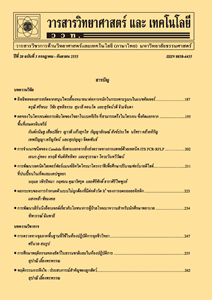ความหลากหลายของพืชอาหารของผึ้งในหมู่บ้านทิพุเย ตำบลชะแล อำเภอทองผาภูมิ จังหวัดกาญจนบุรี
Main Article Content
Abstract
บทคัดย่อ
ศึกษาความหลากหลายของพืชอาหารของผึ้งในหมู่บ้านทิพุเย ตำบลชะแล อำเภอทองผาภูมิ จังหวัดกาญจนบุรี มีวัตถุประสงค์เพื่อศึกษาชนิดของพืชอาหารผึ้งที่ให้เกสรและน้ำหวานแก่ผึ้งในหมู่บ้านทิพุเย โดยศึกษาบริบทชุมชน ตั้งทีมวิจัยซึ่งประกอบด้วยครู นักเรียน นักศึกษา ผู้รู้ในชุมชน หลังจากนั้นสำรวจพืชอาหารผึ้งใน 3 ช่วงเวลา คือ เดือนกุมภาพันธ์ - พฤษภาคม พ.ศ. 2557 เดือนมิถุนายน - กันยายน พ.ศ. 2557 และเดือนตุลาคม พ.ศ. 2556 - มกราคม พ.ศ. 2557 และจัดเวทีแลกเปลี่ยนเรียนรู้ระหว่างนักวิจัยกับชุมชน จากการสำรวจพบพืชอาหารผึ้ง 27 ชนิด 15 วงศ์ เป็นพืชที่ให้เกสรอย่างเดียว 6 ชนิด พืชที่ให้น้ำหวานอย่างเดียว 7 ชนิด ส่วนพืชที่ให้ทั้งเกสรและน้ำหวานมีทั้งหมด 14 ชนิด ช่วงเดือนกุมภาพันธุ์ - พฤษภาคม มีพืชอาหารของผึ้งมากที่สุด ส่วนพืชอาหารของผึ้งทั้ง 3 ช่วงเวลา คือ ไมยราบ และพบผึ้งที่หาอาหาร 4 ชนิด คือ ผึ้งมิ้มเล็ก ผึ้งโพรง ผึ้งหลวง และผึ้งมิ้ม ซึ่งพบผึ้งมิ้มและผึ้งโพรงมากกว่าผึ้งหลวง ส่วนผึ้งมิ้มเล็กพบน้อยที่สุด
คำสำคัญ : พืชอาหารผึ้ง; ผึ้ง
Abstract
The Diversity of Bee Flora at Tipuya, Tambol Chalae, Aumphur Thong PhaPhum, Kanchanaburi Province, Thailand was studied for three periods of the year. The first period was studied between February to May 2014, the second period from June to September 2014 and the third period from October 2013 to January 2014. The methodology was started from the study of community context and local knowledge by interviewed local people and observation. Then the researcher team consisting of teachers, students and the local people was formed. The bee flora was studied and recorded in three periods above, after that the outcome and knowledge of the study was discussed between researchers and community. Twenty seven species (15 families) of bee floral were found. There are 6 species of plants that only pollen source, while 7 species only nectar source and the 14 species provide both nectar and pollen. The most diversity and blooming of bee flora were found during the months of February to May 2014. The Mimosa pudica show as the major pollen source plant of the study site in three periods of the year. During the study we also found 4 species of foraging bee; Apis andreniformis, A. cerana, A. dorsata and A. florea. The most species of bee that found in study site were A. cerana and A. florea while A. andreniformis was hardly found.
Keywords: bee flora, honeybee


